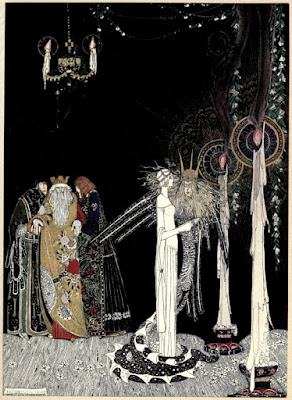Back in September, I did a Shadow Week where I looked at various types of Shadow Elves for the various editions of the game. I mentioned then I had my own in the works. Well, it took me a bit, but here they are. Meet the Shadow Elves. Masters of their arts, but their art can kill you.
Elf, Shadow
aka Umbral Elf
Medium Humanoid (Fey)
Frequency: Very Rare
Number Appearing: 1d8 (2d8)
Alignment: Neutral [Chaotic Neutral]
Movement: 120' (40') [12"]
Armor Class: 8 [11]
Hit Dice: 1d8+1* (6 hp)
THAC0: 18 (+1)
Attacks: 1 weapon or special
Damage: 1d6
Special: See below; Fear immunity
Save: Elf 1
Morale: 8 (10)
Treasure Hoard Class: XX (C)
XP: 19 (OSE) 21 (LL)
Shadow Elves trace their ancestry back to the sundering of the elves and the elvish diaspora. Where some elves fled to the forests of the mortal world, some to deep underground, and others back to their ancestral lands in Faerie, these elves fled to the in-between planes of shadow. Here they changed and became something different than their kin. Like the Ranagwith or "Free Elves" they are rarely encountered.
The Umbral Elves as they are also known are tall, 6 to 6 1/2 feet tall, but thin, weighing only 150 lbs. Their skin is pale white to pale blues. Their hair varies from white to pale blonds to dark blacks. Redheads are rare and are taken as a great omen of change. They speak Elven and any other languages their intelligence scores allow. Due to their life living in the shadowy planes the shadow elf can also see the spirits of the dead and can speak to them (per the Speak to Dead spell). Shadow elves have infravision to 90' and low light vision to 120'. They are not unduly affected by sunlight as the dark elves are but they still do not prefer it. Umbral elves are not just immune to the touch of ghouls they are also immune to the touch of ghasts as well.
These elves are like other elves in that they produce great art, but their art, songs, and poems are all of a melancholic sort. It is said that listing to a Shadow Elf aria can move one to tears. Listing to an opera can move one to suicide. Suicides among shadow elf opera singers are so widespread it has become part of their cultural history. After a perfect performance, knowing they can never achieve more the singer will end their life. Likewise, all their art is breathtakingly beautiful but heartbroken. This has had an effect on the shadow elves as a people. They are completely immune to all fear. Even magical fear, such as from dragons or various fiends, has the effect of angering shadow elves. A failed save on any fear effect only causes them to pause for around. Then they react with anger.
Shadow elves do not have clerics. They feel the gods have forsaken them so they no longer offer them worship or devotion. They do have witches and warlocks that have patrons of primal forces, as well as wizards. For every group of 8 or more shadow elves, one will be a wizard or warlock of the 2nd level. For every group of 12 or more, there will be a wizard or warlock of 3rd level or higher. Shadow elves can take any class elves can save for cleric or paladin. Shadow elves find the "light" elves too frivolous and the "dark" elves too brutal. They do get along well enough with the Ranagwithe (Free Elves) as they see them as fellow outsiders.
Shadow elves, like all elves, are excellent archers, but most prefer not to use missile attacks if they can avoid it. Shadow elves have strict rules of honorable combat. They use specially designed short swords that they dedicate their lives to mastering. The shadow elf warrior prefers hand-to-hand combat. He considers combat to be the highest form of his art and his opponent should not be considered his enemy but something more akin to a dancing partner. Combat without a combatant is only practice. To this end, despite their chaotic alignments, the shadow elf will fight with honor. For example, if their opponent drops or breaks their weapon they will wait till they gain a new one. If they are fighting with a shield and their opponent does not have one the shadow elf will drop their shield as well. Older (higher level) shadow elves will be covered with scars from practice and previous battles. Shadow elves have even been known to weep openly at the death of a particularly powerful combatant; knowing in the pursuit of their own "art" they have destroyed another "artist."
Shadow Elves are found living in underground lairs, particularly dense and dark forests, and in the lands that overlap the Faerie World, the mortal world, and the shadow worlds.
--
Elves are as ubiquitous to the game as dragons are. I wanted an elf that was not something we have seen before. These are not the light elves of Tolkien or the dark elves of myth or even the Drow of Gygax or Salvatore. But they are not the Shadow Elves of Mystara either.
Elves in D&D are immune to the touch of ghouls. Shadow Elves, because part of their origin is the Plane of Shadow, extend that to Ghasts as well.
Since they are elves and not faerie creatures proper their type is Humanoid (Fey). They have some fey properties, but not all. For example, there are no hospitality codes for these creatures and they can handle iron with no issues.
Tomorrow I'll post a proper Fey creature, or maybe two!


























